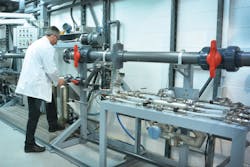The Coriolis flowmeter’s performance in measuring fluid flow in a closed pipe is unmatched. It is arguably the most advanced and reliable technology for process, testing and custody transfer. It measures direct mass flow rate and fluid density and is unaffected by fluid property variations such as pressure, temperature, viscosity and flow patterns. Its acquisition cost is higher than other flowmeters, but when considering total cost of ownership, Coriolis is an option because it diminishes the need for additional instrumentation. It has no moving parts, requires minimal maintenance and offers long-term stability and reliability. It is increasingly used in critical applications such as fuel measurement in aerospace, pharmaceutical manufacturing and mass transfer in oil and gas processes.
After a period of operation, it is necessary to verify instrument performance and measurement accuracy. A flowmeter may fall out of calibration for several reasons: physical modifications and corrosion within the process; internal parts can gradually degrade and affect the meter’s performance; or process variations, initialization or inadequate procedures can cause an impact.
Integrated electronic diagnostics, in-situ proving and validations are reliable methods that ensure meter efficiency, but periodic calibration in a laboratory is always essential because it:
- Ensures homogeneity and repeatability of the instrument’s performance
- Reduces process variations over time (measurement errors)
- Avoids product recalls
- Respects the company’s quality system or governing body requirements
Measurement uncertainty
Most manufacturers publish an accuracy of ±0.1 percent or better. This is impressive considering that some provers and primary standard rigs do not even match that level of accuracy. A leading Coriolis flowmeter brand claims a standard accuracy of ±0.1 percent and optional ±0.05 percent on its high-end model, including the combined effects of repeatability, linearity, hysteresis and orientation.
However, it is important to understand the difference between meter accuracy and total uncertainty of the measured value. Accuracy has been calculated by evaluating the performance of the meter’s output while the total uncertainty includes the error generated by the transmitter, improper zeroing, fluid properties and environmental conditions.
In a laboratory with a controlled environment and optimal conditions, errors generated by external sources, fluid properties and installation effects are negligible. Extended uncertainty of measured value equals accuracy (whichever is greater, between zero stability and meter’s stated accuracy) plus error generated by the transmitter. Most manufacturers do not mention output tolerance in product specifications, which can create misconceptions of total uncertainty. Also, transmitters offer better total uncertainty using frequency and digital outputs over the analog output, which is frequently used despite low resolution.
Another important factor that affects accuracy is zero stability, an inherent Coriolis flowmeter characteristic. It significantly affects accuracy when the measured flow rate approaches the low end of full range. Typically its effect begins when turndown is greater than 20-to-1. Above this threshold, accuracy equals zero stability/flow rate times 100 percent.
ISO 17025 & calibration measurement uncertainty
ISO 17025 is an international standard for evaluating laboratories and specifies the requirements for the competence to carry out calibrations. It ensures the calibration process is traceable to national and international standards. The accrediting body ensures personnel remain technically competent and the laboratory has a quality system where measurements consistently produce valid and repeatable results within the scope of accreditation.
The accreditation procedure includes evaluation of the measurement uncertainty of each component on the calibration rig and interlaboratory proficiency testing with other ISO 17025 accredited labs. The “expanded calibration measurement uncertainty” is required to issue a calibration certificate with a statement of compliance. In other words, it indicates whether each test point passes or fails.
The laboratory then calculates a Test Uncertainty Ratio (TUR), the ratio between the accuracy of the tested device being tested and the total uncertainty of the reference measure. If the TUR is greater than 4-to-1, good probability exists within the confidence interval that all measured values are compliant or noncompliant (pass or fail).
ISO 17025 requires the guardbanding technique be applied for each test point when the TUR is less than 4-to-1. The primary objective is to control the risk of accepting an out-of-tolerance unit or rejecting an in-tolerance unit. It restricts compliance limits based on certain criteria and can lead to situations in which it is impossible to determine pass or fail status. When the test measurement is too close to the upper or lower limit, it could be declared undetermined. This too-close tolerance depends on the established confidence level and the laboratory’s guardbanding strategy.
Calibration methods
Many measurement methods exist for flowmeter calibration. From high-end primary standards to transfer standard meters, the selection of the method and the importance of the uncertainty of the measures become essential criteria in the decision-making process for the selection of the calibration laboratory.
One common mistake is to accept a volumetric calibration when the flowmeter is used for measuring mass flow. The correlation between a volumetric flow and a mass flow is density. If the lab measures volumetric flow rate and does not have a density measurement, no traceability exists in the mass flow rate and the calibration has no value for a Coriolis flowmeter used for mass transfer.
It is challenging to find a laboratory capable of achieving better uncertainty than the accuracy of a Coriolis flowmeter. A highly accurate Coriolis can be used as a transfer standard meter to calibrate other types of flowmeters and other Coriolis meters. These meters are proficiency testing artifacts traceable to a primary flow standard. They can achieve an impressive ±0.03 percent total uncertainty, although they do not quite achieve the 4-to-1 TUR.
Another approach to achieving high accuracy is the use of a primary standard rig by gravimetric method. Gravimetric calibration consists of weighing the quantity of fluid during a time period, consequently measuring mass flow rate. Some calibration laboratories that use this method have achieved calibration uncertainty of ±0.02 percent or better. It is recommended that a highly accurate Coriolis flowmeter be calibrated by this method to ensure optimal calibration measurement uncertainty.
Calibration by manufacturer or independent laboratory
Whether meter calibration performed directly by the manufacturer warrants better accuracy is an ongoing debate.
A manufacturer’s calibration services have advantages. The laboratory offers additional services such as extensive repairs and defective unit rebuilds. The manufacturer, a specialist of its own product, is more apt in identifying sensor failures and wears and tears of the tube. The manufacturer also has access to advanced features and diagnostic tools.
Alternatively, independent labs often provide calibration adapted to specific customer needs and can evaluate the true meter’s metrological performance (total uncertainty of measured value), providing a whole system (including the transmitter) and/or source-to-screen calibration. The manufacturer usually performs a default factory calibration as a standard service, sometimes generating new meter factors or resets with original factory settings.
It comes down to one question: How important is the flow rate measurement in the process or test? An expensive Coriolis flowmeter was purchased. A cost analysis was performed and the cost of a failure or shifted measurement was identified. If it is regulated, it is compliant and respects calibration requirements.
Ultimately, a laboratory must meet four conditions to perform optimal calibration on Coriolis meters. It must be:
- ISO 17025 accredited with a calibration procedure by gravimetric method specific to Coriolis flowmeters
- Competent in calibration performance with a measurement uncertainty of four times better than the uncertainty of the meter
- Specialized in Coriolis mass flow technology
- Willing to adjust to the customer’s conditions and specific requirements
And most importantly, service must come with a smile.
Martin Richer is sales manager at Polycontrols Technologies and has been a partner since 2014. He participated in the flow calibration laboratory growth through business development and the implementation of best practices in customer service.



